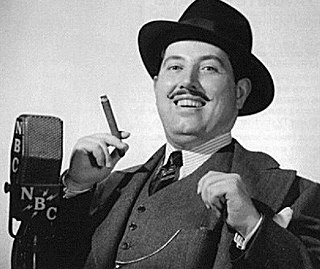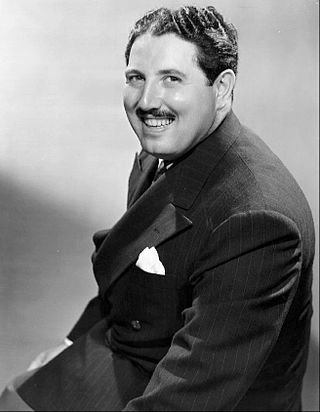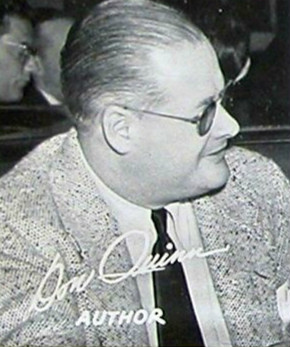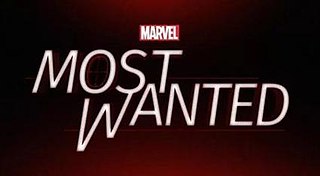
Fibber McGee and Molly (1935–1959) was a longtime husband-and-wife team radio comedy program.

A sequel is a work of literature, film, theatre, television, music or video game that continues the story of, or expands upon, some earlier work. In the common context of a narrative work of fiction, a sequel portrays events set in the same fictional universe as an earlier work, usually chronologically following the events of that work.

Arthur Quirk Bryan was an American actor and radio personality. He is best remembered for his longtime recurring role as well-spoken, wisecracking Dr. Gamble on the radio comedy Fibber McGee and Molly and for voicing the Warner Brothers cartoon character Elmer Fudd.

Mobile Suit Victory Gundam, is a 1993 Japanese science fiction anime television series. It consists of 51 episodes, and was directed by Gundam creator Yoshiyuki Tomino. The series was first broadcast on TV Asahi. It is the fourth TV anime installment in the Gundam franchise, first series in the franchise released in Japan's Heisei period, and the final full series to be set in the Universal Century calendar.

The Great Gildersleeve is a radio situation comedy broadcast in the United States from August 31, 1941 to 1958. Initially written by Leonard Lewis Levinson, it was one of broadcast history's earliest spin-off programs. The series was built around Throckmorton P. Gildersleeve, a regular character from the radio situation comedy Fibber McGee and Molly. The character was introduced in the October 3, 1939, episode of that series. Actor Harold Peary had played a similarly named character, Dr. Gildersleeve, on earlier episodes. The Great Gildersleeve enjoyed its greatest popularity in the 1940s. Peary played the character during its transition from the parent show into the spin-off and later in four feature films released at the height of the show's popularity.
A story arc is the chronological construction of a plot in a novel or story. It can also mean an extended or continuing storyline in episodic storytelling media such as television, comic books, comic strips, board games, video games, and films with each episode following a dramatic arc. On a television program, for example, the story would unfold over many episodes. In television, the use of the story arc is common in sitcoms, and even more so in soap operas. In a traditional Hollywood film, the story arc usually follows a three-act structure. Webcomics are more likely to use story arcs than newspaper comics, as most webcomics have readable archives online that a newcomer to the strip can read in order to understand what is going on. Although story arcs have existed for decades, one of the first appearances of the term was in 1973 by Time Magazine for a synopsis of the movie The Friends of Eddie Coyle: "He accomplishes this with no sacrifice to the pacing of his action sequences or the suspenseful development of his story's arc."

A crossover is the placement of two or more otherwise discrete fictional characters, settings, or universes into the context of a single story. They can arise from legal agreements between the relevant copyright holders, common corporate ownership or unofficial efforts by fans.
A supporting character is a character in a narrative that is not the focus of the primary storyline, but is important to the plot/protagonist, and appears or is mentioned in the story enough to be more than just a minor character or a cameo appearance. Sometimes, supporting characters may develop a complex backstory of their own, but this is usually in relation to the main character, rather than entirely independently. In television, supporting characters may appear in more than half of episodes per season. Some examples of well-known supporting characters include Watson in the Sherlock Holmes stories, Donkey in the Shrek films, and Ron Weasley in the Harry Potter series.

Harold "Hal" Peary was an American actor, comedian and singer in radio, films, television, and animation. His most memorable role is as Throckmorton P. Gildersleeve, which began as a supporting character on radio's "Fibber McGee and Molly" in 1938.
The Halls of Ivy is an American situation comedy that ran from 1950 to 1952 on NBC radio, created by Fibber McGee & Molly co-creator/writer Don Quinn. The series was adapted into a CBS television comedy (1954–55) produced by ITC Entertainment and Television Programs of America. British husband-and-wife actors Ronald Colman and Benita Hume starred in both versions of the show.

Baki the Grappler is a Japanese manga series written and illustrated by Keisuke Itagaki. It was originally serialized in the shōnen manga magazine Weekly Shōnen Champion from 1991 to 1999 and collected into 42 tankōbon volumes by Akita Shoten. The story follows teenager Baki Hanma as he trains and tests his fighting skills against a variety of different opponents in deadly, no rules hand-to-hand combat.

Fairy Tail is a Japanese manga series written and illustrated by Hiro Mashima. It was serialized in Kodansha's Weekly Shōnen Magazine from August 2006 to July 2017, with the individual chapters collected and published into 63 tankōbon volumes. The story follows the adventures of Natsu Dragneel, a member of the popular wizard guild Fairy Tail, as he searches the fictional world of Earth-land for the dragon Igneel.

Don Quinn was an American comedy writer who started out as a cartoonist based in Chicago. According to sources, Quinn's career as a cartoonist was short-lived but his career as a writer began after he realized that the magazines and newspapers threw away his drawings he sent in but kept his captions.

Look Who's Laughing is a 1941 film from RKO Radio Pictures. The film is built around a number of radio stars from the Golden Age of Radio and centers around radio personality Jim Jordan as Fibber McGee from the comic duo, Fibber McGee and Molly, who plans to build an aircraft factory in a small town. Look Who's Laughing was followed by Here We Go Again (1942), with many of the radio stars reprising their performances.

Here We Go Again is a 1942 American film, a sequel to Look Who's Laughing. With RKO in financial trouble, with the success of the earlier zany comedy starring a bevy of radio stars, Here We Go Again put Fibber McGee and Molly in a search for where to celebrate the couple's 20th anniversary. They want to throw a big party but when everyone declines their invitation, they decide to go on a second honeymoon instead.

Marian Irene Driscoll Jordan was an American actress and radio personality. She was most remembered for portraying the role of Molly McGee, the patient, common sense, honey-natured wife of Fibber McGee on the NBC radio series Fibber McGee and Molly from 1935 to 1959. She starred on this series opposite her real-life husband Jim Jordan.

Marvel's Most Wanted is an unaired American television pilot created by Jeffrey Bell and Paul Zbyszewski for ABC, based on the Marvel Comics characters Bobbi Morse and Lance Hunter. It is set in the Marvel Cinematic Universe (MCU) and acknowledges the continuity of the franchise's films and other television series. A spin-off from Agents of S.H.I.E.L.D., the pilot was written by Bell and Zbyszewski, and directed by Billy Gierhart.
Hokuto Gaiden is a series of spin-off works by various authors based on the Hokuto no Ken manga by Buronson and Tetsuo Hara. They were all published in Weekly Comic Bunch between 2006 and 2010, with the exception of Jibo no Hoshi, which was published in Big Comic Superior. Each spin-off is set at some point during the Hokuto no Ken continuity and features a supporting character from the original manga as a protagonist.

Hei, also known as Li Shenshun, is the protagonist of the 2007 anime Darker than Black by Bones. Codenamed "Hei", he is portrayed as a Contractor, a man with supernatural powers with Hei being able to generate electricity. In Tokyo, Hei works for an organization known as the Syndicate and earns the nickname "Black Reaper" due to his skills as an assassin. During the series, Hei's backstory of his mission involving his missing sister is developed. Hei also appears in the sequel Darker than Black: Gemini of the Meteor as the mentor of young Contractor Suo Pavlichenko while searching for his partner, Yin. He is also present in the inter-sequel original video animations Darker than Black: Gaiden, which explores his escape from the Syndicate with Yin between the events of both anime.

Darker than Black: Gaiden is a Japanese original video animation (OVA) series created by studio Bones and directed by Tensai Okamura. It is a sidesequel to the anime television series Darker than Black and a prequel to Darker than Black: Gemini of the Meteor. It consists of four episodes about the main character Hei and his partner Yin, with the events taking place between both seasons. After betraying the Syndicate organization, Hei and Yin escape from Japan to live a peaceful life, but Yin later develops a god-like alter ego that causes mayhem.
















